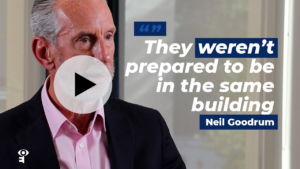Workplace Mediation Case Study: Rebuilding Dialogue and Collaboration in a Fractured Workplace
Overview
Mediator: Neil Goodrum
Sector: National organisation
Outcome: Clear communication protocols and conflict resolution procedures were established to prevent future misunderstandings and promote a collaborative working relationship.
Background
Two individuals within an organisation found themselves in a state of deep conflict. Communication had ceased entirely, and they couldn’t even be in the same building without tension escalating. This impasse threatened collaboration and efficient operations within their team.
The Challenge
Bridging the communication gap and creating a framework for future collaboration despite the animosity. The mediator needed to work indirectly, earning trust and facilitating dialogue even when direct interaction was impossible.
The Mediator’s Approach
Indirect Communication: Instead of forcing a face-to-face meeting, the mediator communicated with each individual separately, building trust and understanding their perspectives.
Building Trust: By actively listening and demonstrating empathy, the mediator established a safe space for both parties to express their concerns without fear of judgment.
Facilitating Dialogue: Once trust was established, the mediator acted as a bridge, transmitting messages and concerns back and forth between the parties, gradually paving the way for direct communication in the same room
The Outcome
Restored Communication: With the mediator’s help, the parties finally re-established direct communication within a neutral and safe environment.
Mutual Understanding: Through open dialogue, both parties gained a deeper understanding of each other’s viewpoints and the underlying causes of the conflict.
Collaborative Framework: Together, they established clear communication protocols, conflict resolution procedures, and regular meeting schedules to maintain cooperation and address future issues proactively.
Long-Term Sustainability: The mediator fostered an environment where the parties could independently manage their communication and collaboration, with the option to seek support if needed.
Key Learnings
In highly charged situations, indirect communication can be a valuable tool to build trust and pave the way for direct interaction.
Active listening, empathy, and a neutral stance are crucial for a mediator to gain the trust of both parties involved in a conflict.
Mediators should aim to empower individuals to independently manage their communication and collaboration, but remain available for support if needed.
Conclusion
This case study demonstrates the power of effective mediation in resolving even the most entrenched workplace conflicts. By fostering trust, facilitating dialogue, and establishing a framework for future collaboration, mediators can bridge divides and create conditions for a more productive and harmonious work environment.



